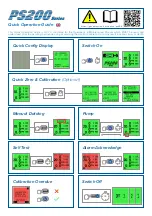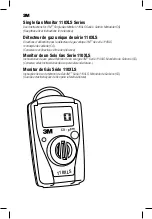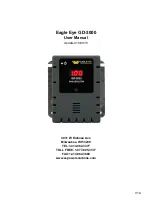
-1-
1. Introduction
Thank you for purchasing the New Cosmos PS-7 series extractive pump gas detector. Before using it,
please read this instruction manual carefully to ensure reliable and safe operation.
This unit detects semiconductor process gas or combustible gas (e.g., hydrogen) that may be present in a
cylinder cabinet, an exhaust duct, or an industrial facility work environment (e.g., semiconductor
manufacturing plant) and transmits the gas concentration value as an analog signal to an external device
while simultaneously showing the gas concentration value on its display.
If the gas concentration reaches the preset level, the red ALARM LED will start flashing and activate the
relay contacts, thus monitoring the concentration of the leaked target gas.
Sensor and sampling units can be easily replaced without tools. After the replacement of a sensor/sampling
unit, on-site calibration using a prepared gas is not necessary.
Periodic maintenance is essential to maintain the reliability of the detector. Therefore, perform periodic
maintenance in accordance with the instructions given in this manual.
PS-7 series gas detectors are divided into the following six models according to the sensor unit type and
with/without a pyrolyzer. For sensor selection, please contact New Cosmos or its authorized representative.
Sensor unit type
With
communication function
Without
communication function
(COMM-less model)*
Toxic gas sensor unit
CDS-7
PS-7-01
PS-7-04
Combustible gas sensor unit
CHS-7
Oxygen sensor unit
COS-7
PS-7-02
Toxic gas sensor unit and
pyrolyzer CDS-7+CDP-7
PS-7-03
―
Toxic gas sensor unit with built-in
pyrolyzer CDS-7
PS-7-05
PS-7-06
* COMM-less models are not equipped with Personal Digital Assistant (PDA) communication or
DeviceNet communication function, and do not comply with CE marking.
* A DeviceNet unit (sold separately, specified during order placement) is required to use DeviceNet
communication.
Symbols Used in this Instruction Manual
This manual uses Danger, Warning, Caution and Note symbols to draw attention to procedures, materials,
methods, and processes, which require particular attention.
DANGER
Indicates an imminently hazardous situation that can result in
death or serious injury.
WARNING
Indicates a potentially hazardous situation that may result in death
or serious injury.
CAUTION
Indicates a hazardous situation that may result in minor injury or
property damage.
NOTE
Provides information on product handling.




































